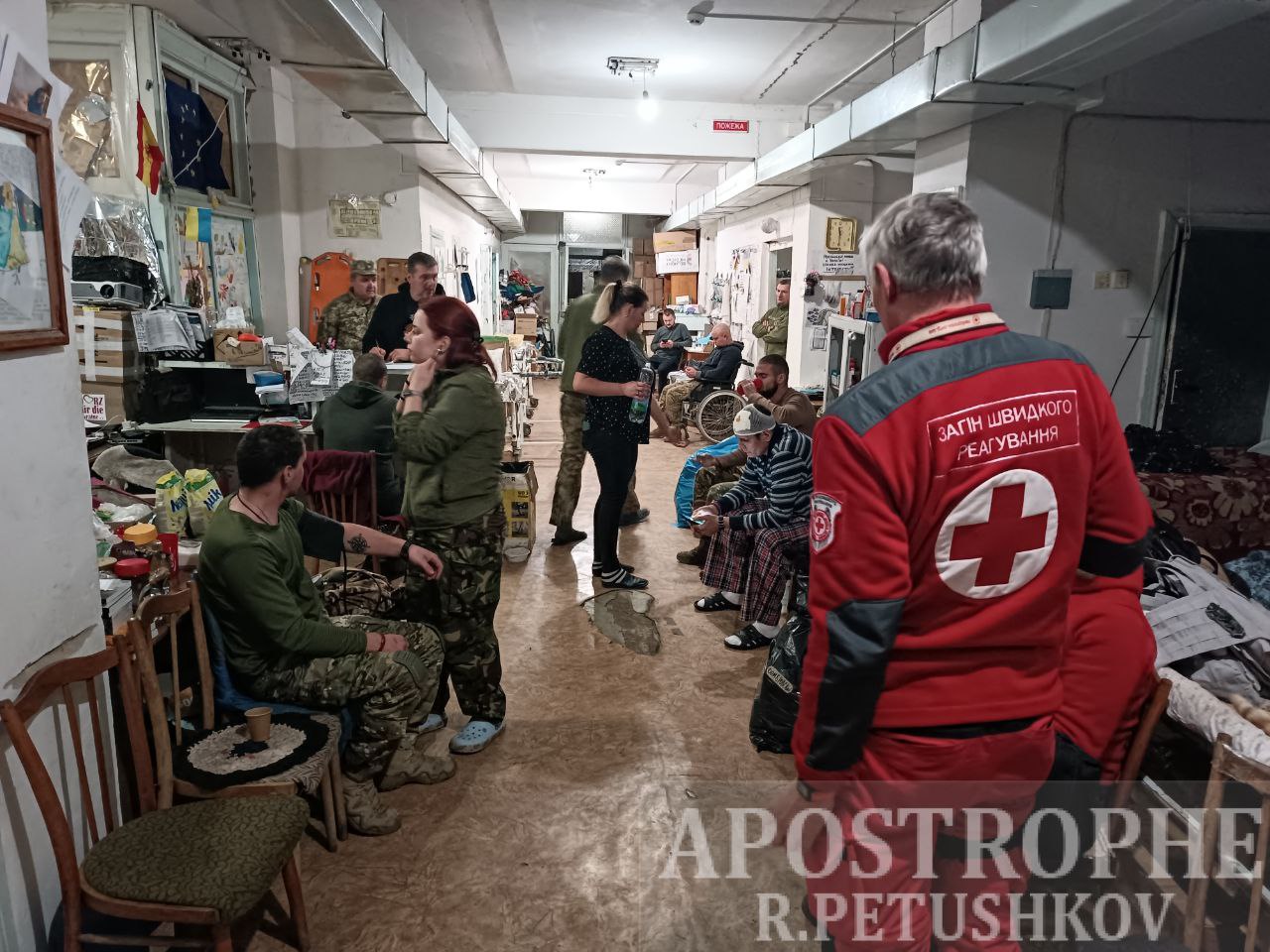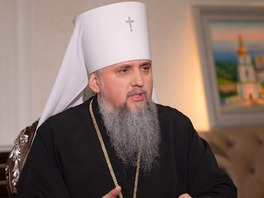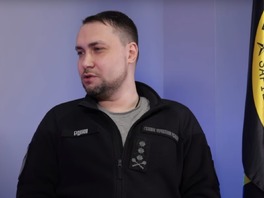In Ukrainian, the term ‘stabilization point’ or ‘stabpunkt’ refers to the spot where combat medics bring the wounded soldiers from the front line. It's the place where the injured get initial aid in a relatively safe setting. This is where medics conduct thorough examination of the wounded soldier, and all the necessary procedures for their further evacuation to rear hospitals are carried out. It's dubbed a ‘stabilization point’ or just ‘stab’ because its goal is to ‘stabilize’, that is to do everything possible to get the injured out of critical condition and ready for transportation. These stabilization points are usually situated close to the conflict zone, acting as field hospitals under basic conditions but equipped with everything needed to save lives. A correspondent from "Apostrophe" got involved in the operations of one of these points.
.Feeling stressed? Pet the cat
There are several dozen people constantly working at ‘stab’. These include military medics from the military brigade and staff from the First Volunteer Mobile Hospital named after Mykola Pyrohov. Recently, volunteers from the Emergency response teams of the Ukrainian Red Cross received permission to assist at the ’stabs’. The latter are mainly involved in medical evacuation to rear hospitals and even handling domestic tasks. They are sorting humanitarian aid and clothing intended for dressing wounded soldiers after surgical operations. Sometimes, volunteers are involved in providing direct medical assistance.
Upon the arrival of an injured soldier, there is a seamless understanding of the necessary actions without unnecessary inquiries. Medical personnel conduct an examination, other staff members gather essential supplies, a designated specialist enters the patient's data into the database, and concurrently, volunteers gather the soldiers' personal items, label them, and pack them into bags for transportation to the hospital.
If it is necessary to wait for transportation, the fighter is offered tea, given a meal, cheered up, and provided with a dry ration.
The front line is extremely close here; cannonades echo all the time. We could hear the sounds of Ukrainian artillery at work, as well as the sounds of Russian artillery shells falling very close by. One may step outside not more than for a couple of minutes for a smoke break because an enemy drone could easily spot us. The ‘stab’ tremors after the powerful shells explosions outside. ‘...It's really close now,’ sighs one of the medics. I ask him about the situation. ‘Today, for some reason, they've become more active; it was quiet before. When the Russians were attempting to capture Bakhmut, it was hell; shells were randomly flying everywhere, even hitting our settlement frequently. We had to move evacuation vehicles several kilometers away and conceal them in the fields, managing to evacuate up to 110 wounded daily. Constant bandaging, resuscitation efforts, and dozens of trips to rear hospitals, and that's just at our stab,’ says the medic with a vivid yet sad and tired look.
‘When will these scoundrels leave us alone,’ says the nurse, who also stepped out for a break. It's already dark outside, and we observe constant flashes on the horizon and hear explosions. ‘The Russians have launched an offensive,’ adds the nurse, lighting a cigarette. Our artillery starts working from the fields nearby. Hopefully, they hit the target accurately.
When there are no casualties, life on the 'stab' goes on as usual. The staff consistently maintain cleanliness, rearrange things, conduct training sessions, and engage in medical discussions. Meals are delivered instead of being prepared on-site, and everyone is aware of the designated mealtime; personnel is responsible for cleaning up after themselves. There are calm days at the ‘stab’ when no injured individuals are brought in. In such cases, the team can take a bit of a break; the male personnel watches football, and there is also a projector to show films. A ginger cat lives at ‘stab’, unfortunately, with a spinal injury, but is still able to move around. Everyone here loves him. They call him Ginger, Stabby, and even Garfield. He serves as a calming, therapeutic presence. Feeling stressed? Pet the cat.
Evacuation
We took shifts at the stabilization point for two days, working for 12 hours each day, from 8 a.m. until 8 p.m.. During this time, there were relatively few wounded soldiers, which is indeed good news. However, volunteers from the Emergency response teams still managed to conduct two evacuations during the day.
Evacuation is also a significant risk. Approximately 6 kilometers of the route to the stabilization point pass through a road near the front line that is constantly under gunfire. There was greenery here in the summer at least, now there are bare trees, making it easy for an enemy drone to spot us. The road is full of potholes and bumps, thus maximum speed is 40 kilometers per hour.
‘Here, you see that crater,’ says our driver, also a volunteer from the Emergency Response Teams, who has undergone several rotations on evacuation missions during the full-scale war. ‘Some volunteers broke down right here; an enemy drone spotted them and targeted them directly. Breaking down here is a really crappy story. Artillery, MLRS, and especially the enemy's Lancets can reach this place.’
We reach the ‘stab’. It's relatively safe here. An hour later, during a break, we hear gunfire from small arms. 'Enemy drone,' say the paramedics. Within a minute, a significant explosion occurs on the side of the road we just traveled. Another minute passes, and we hear two sets of approximately dozens of impacts. 'That's Grad, everyone inside now,' commands one of the medics.
Thus, evacuation. The medic asks our team if we can take three wounded patients capable of sitting. ‘Yes, of course!’ we respond. We don bulletproof vests and helmets, grab personal first aid kits, and medical tourniquets, following safety protocols. Each of us knows in advance what gear we have in case of an attack. We accompany the injured individuals aboard our evacuation minibus. One of them has sustained a head injury, while the other two have concussions. It is essential to monitor their condition closely, particularly the concussed individuals who are experiencing headaches, disorientation, and anxiety. Continuous check-ins of their well-being are necessary due to the rough road and constant maneuvering, which can induce nausea. Luckily, the soldiers' conditions are stable, with one of them being quite young, born in 1998.
We bring the patients to the hospital, where medics are already expecting us. We hand over patients’ belongings, documents detailing injuries, and information about the procedures performed at the stabilization point. Within three minutes after us, two more ambulances arrived at the hospital with more severely injured patients. We let them go ahead. We entrust the individuals to the medical staff, providing their belongings and medical records. The patients convey their thanks, and we return to the stabilization point as we still have the remaining half of our shifts to complete.
After some time, an additional casualty arrives. His injuries are of moderate severity, with shrapnel wounds to the arm and neck. The medics perform medical procedures behind closed doors, and after 10 minutes, they entrust the patient to us for transportation to the hospital. We transport him calmly, and during the entire journey, the man converses with his family via the phone, reassuring them and emphasizing that his injuries are not critical, and the most important thing is that he is still alive.
The coolest rescuer teams
The Red Cross Emergency Response Teams are actively involved in eastern battles after the battle for Kyiv was over and resulted in the victory of Ukrainian troops. Previously, they were engaged in evacuations from cities such as Irpin, Bucha, Hostomel, and others along the Kyiv direction. The Kyiv unit is currently deployed in the Donetsk region, with each rotation lasting 21 days and crews assigned new missions daily. There is no downtime; volunteers check the condition of vehicles, recharging the equipment, and maintain the base if there are no emergencies. Volunteers consistently conduct training sessions on first aid and proper equipment usage.
Currently, volunteers are involved in rescuing soldiers. During active combat in Lyman and Svyatohirsk, they transported tons of humanitarian aid and evacuated civilians. Throughout their time in the East, the Emergency Response Teams have saved thousands of people and delivered hundreds of tons of cargo. For instance, the previous rotation transported 280 wounded soldiers and covered over 18,000 kilometers.
In eastern Ukraine, there are only four Emergency Response Teams crews in total. One crew consistently mans the stabilization point and can be reinforced by an additional team if necessary. The other crews operate 24/7, carrying out evacuations from various frontline hospitals to locations nearer to Dnipro. The process is continuous: a call, departure, and the handover of the wounded at a designated point. Why? This approach eliminates the need to rush ambulances directly from Dnipro's rear, where medical facilities are situated, to places like Pokrovsk or Sloviansk that are closer to conflict zones but not constantly under attack. Along the route, transfer points facilitate the exchange of patients as vehicles move toward each other. Despite this efficient process, a single round trip still takes approximately 4-5 hours.
In cases where a patient is in a severe condition, the Emergency Response Teams are equipped with fully functional ambulances containing all essential equipment, including monitoring systems for the patient's condition and oxygen cylinders. The teams comprise medical professionals, although, on the day of our shift, they were assigned to different tasks in other directions.
In the eastern region, there are resilient individuals, the most exceptional rescuers of our soldiers, who are always ready to assist anyone in need. They have successfully saved thousands of lives. The stabilization points will undoubtedly be remembered in history as one of the pivotal factors in achieving victory over the enemy in this war.






